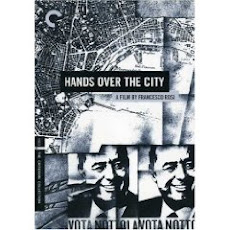“about” the confusion in watching as it is about a putative narrative. Another way of saying this is that the film is a narrative that's also an experiment in narration. It's a tough (impossible?) narrative to parse out fully, and I cannot claim any special insight. What I'm tying to figure out – and I'd love to hear what others see – is how exactly the narrational experiment works. After all, it seems that L'Intrus is less capricious in its storytelling than in a rigorous presentation of information that induces confusion (among other responses) in the spectator.
The rigor, I suspect, lies in the heritage of the art cinema in L'Intrus as well as Denis's departures from art cinema. Like the art cinema, L'intrus plays with ambiguous presentation of narrative events. Unlike art cinema, it suggests that a coherent narrative exists behind the storytelling, that we are watching events excerpted and condensed to the straining point of comprehensibility. In this, the narration relies extensively on ellipsis and secondarily on the possibility that an abrupt cut signals not the usual ellipsis but flashforward, flashback, or subjective material (dreams?). The following shot sequence seems typical:









 On one hand these seem to fall neatly into scenes (continuous time-place chunks of narrative): shots 1-2 end scene A (Hong Kong party), the last shot begins scene C (boat ride to Tahitian isle), and the ones in between comprise scene B (flight to Tahiti). On the other hand, the demarcation into scenes presents problems. First, while we as viewers of art and postclassical films are used to the "shock cut" transition to a new scene, all of the transitions in L'Intrus proceed the same way. That is, they lack the conventional "punctuation" signaling a scene transition (type of edit + timing of the edit in relation to the completion of screen action). The only way the spectator can create "scenes" out of the shots in L'Intrus is to recognize common characters and settings - they/we lack the cues in the editing. In art films, transition punctuation can be avoided selectively (one of my favorite examples is the shock cut in Il Posto from the New Year's party to solemn office) but is rarely ignored for the entire film.
On one hand these seem to fall neatly into scenes (continuous time-place chunks of narrative): shots 1-2 end scene A (Hong Kong party), the last shot begins scene C (boat ride to Tahitian isle), and the ones in between comprise scene B (flight to Tahiti). On the other hand, the demarcation into scenes presents problems. First, while we as viewers of art and postclassical films are used to the "shock cut" transition to a new scene, all of the transitions in L'Intrus proceed the same way. That is, they lack the conventional "punctuation" signaling a scene transition (type of edit + timing of the edit in relation to the completion of screen action). The only way the spectator can create "scenes" out of the shots in L'Intrus is to recognize common characters and settings - they/we lack the cues in the editing. In art films, transition punctuation can be avoided selectively (one of my favorite examples is the shock cut in Il Posto from the New Year's party to solemn office) but is rarely ignored for the entire film.Second, the scenes above cohere in space-time but aren't scenes as we often understand them. In a classical film, action is concentrated in scenes so that the action between scenes is insignificant. The above example would seem to follow this practice: it is not narratively important to see Louis leave Hong Kong, arrive at the airport, catch a cab from the Tahitian airport to the boat, etc. Yet, often the narratively significant action does take place between scenes.
The scene in which Louis wraps up the dead body is a case in point...

We do not know what becomes of the body, who the dead man is, how or why he ended up on Louis's property. (Tell me if I'm missing something!) In an art film or a post-classical puzzle film, this kind of enigma could be evoked only to be answered later one - the puzzle film, in fact, is defined by the tidy-ness in which it answers these enigmas. But without such resolution, shots and scenes like these function as pure, floating narrative semes, basic building blocks of narrative information that never actually build into anything.
Forgive me if I'm belaboring the obvious; I'm trying to articulate why I find the film so difficult and alluring. I'm certainly curious what others make of the film and its narrative stategies.




